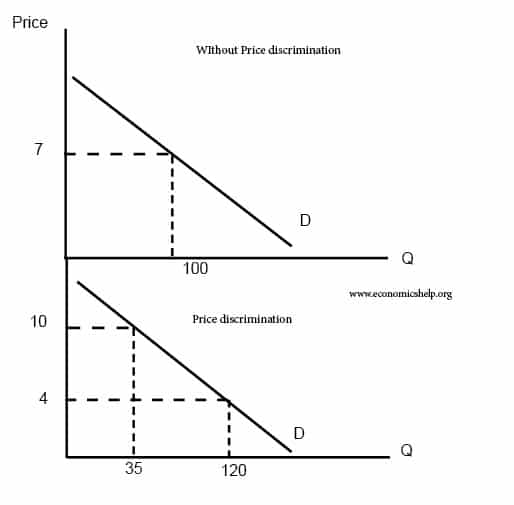Why Does Price Discrimination Explain Price Differences
1 It is one of the competitive practices along with. Think about when a store runs a sale.

Price Discrimination Economics Help
This kind of price discrimination may give favored customers an edge in the market that has nothing to do with their superior efficiency.

. On the other hand a price-discriminating monopoly is a firm that can offer distinct units of a good or service for varying prices. A lower price to consumers whose demand is more elastic. Firms can generate additional revenues by charging more to customers with inelastic.
It a firm has to charge the same price to all customers P M and Q M will maximize profits. According to Stigler Price discrimination is the sale of various products at prices which are not proportional to their marginal costs In the words of Dooley Discriminatory monopoly means charging different rates from different customers for the same good or service. Womens price Mens priceDry-cleaners reason for discrepancy Example 9 625 255 Womens shirts cost more to dry-clean because starch is used Example 10 300 250 or 275 if boxed No explanation provided.
There are three types of price discrimination. Price discrimination is the practice of charging a different price for similar products when the price differences are not attributable to differences in costs. That means instead of charging all consumers one single price they set different prices for different customers depending on the maximum amount these customers are willing to pay.
Terms in this set 9 A firm carries out price discrimination when it charges. Other than the cinema business price discrimination is also used in the travel industry. First they charge the normal price P M and sell the normal quantity Q M.
First of all therefore the monopolist has to divide his total market into various sub-markets on the basis of differences in price elasticity of demand in them. The main principle behind price discrimination is that a firm is trying to make use of different price elasticities of demand. As a result a discriminating monopoly charges various rates to different customers or markets.
Price discrimination occurs when identical goods or services are sold at different prices from the same provider. Price discrimination is one way to manage demand. Example 11 900 380 Womens shirts cost more to dry-clean because they have darts.
Price discrimination is the practice of charging different customers or groups of customers different prices for the same product. Suggest and justify whether any other role should be recommended. Price discrimination can be first-degree charges different prices for various groups second-degree charges different prices for different groups or third.
These groups often have less disposable income than the average consumer. Price discrimination is possible only when the buyers from different sub-markets are willing to purchase the same product at different prices. Price discrimination means that firms have an incentive to cut prices for groups of consumers who are sensitive to prices elastic demand.
But if it can price discriminate it can make even more profits. Explain the role of your company if it is considered the dominant company in the industry in terms of price leadership. Second degree the price of the good or service varies according to quantity demanded.
But under price discrimination the monopolist will charge different prices in different sub-markets. When the monopolist does not charge a uniform price for his product the model is called discriminating monopoly. Price discrimination takes us away from the standard assumption in that there is a single profit-maximising price for the same good or services.
To price-discriminate the firm must be able to distinguish groups of buyers with different price elasticities of demand. If some people have a very inelastic demand it means they are willing to pay a higher price. First degree the seller must know the absolute maximum price that every consumer is willing to pay.
If the elasticity of demand is the same then the effect of the price change on the buyer will be. Price discrimination happens when a firm charges a different price to different groups of consumers for an identical good or service for reasons not associated with costs of supply. Under simple monopoly a single price is charged for the whole output.
Price discrimination means charging different prices to different customers for the same product. Price discrimination is the strategy of a business or seller charging a different price to various customers for the same product or service. First-degree price discrimination alternatively known as perfect price discrimination occurs when a firm charges a different price for every unit consumed.
If the firm can set higher prices for these consumers it can increase its revenue and profits. Price discrimination arises naturally in the theory of monopoly and oligopoly. Price discrimination occurs when firms charge individual customers or groups of customers different prices for the same goods or services.
To the consumers price discrimination results to a decline in con summer prices. Different prices can be charged for different units only when the. The firm is able to charge the maximum possible price for each unit which enables the firm to capture all available consumer surplus for itself.
The downside is that some consumers will face higher prices. Also it results to an increase in the prices of the same product which could be obtained at a lower price if it was bought in a different market segment Liu Tong 2009 p72. Price discriminations are generally lawful particularly if they reflect the different costs of dealing with different buyers or are the result of a sellers attempts to meet a competitors offering.
Whenever a good is sold at a price in excess of its marginal cost there is.

Price Discrimination Conditions For Price Discrimination With Examples

No comments for "Why Does Price Discrimination Explain Price Differences"
Post a Comment